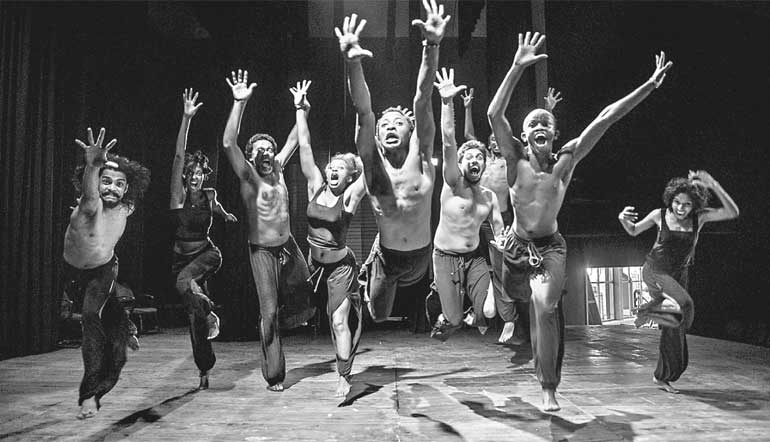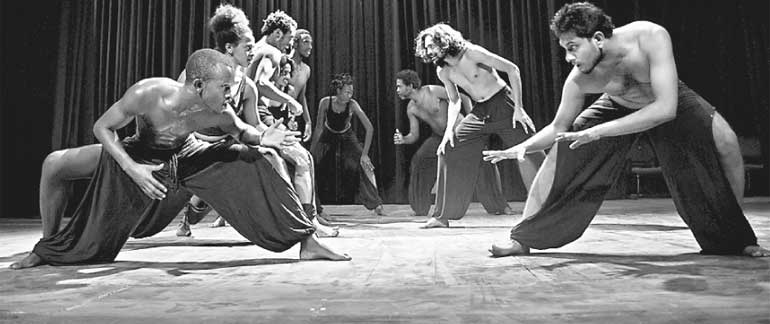Thursday Jan 01, 2026
Thursday Jan 01, 2026
Saturday, 6 February 2016 02:38 - - {{hitsCtrl.values.hits}}
A review of ‘Dear Children…’s’ efforts at insight and higher understanding
By Uditha Jayasinghe
‘Dear Children…’ was the theatrical equivalent of a time machine created to bridge generations. Appropriately the latest project by acclaimed playwright Ruwanthie de Chickera went on the boards just ahead of the annual trite Independence Day ceremony and gave the audience much to think about but perhaps not enough to engage with.
During a previous interview with the Daily FT, Ruwanthie gave a definitive breakdown of her idea of art. “For something to remain within the realm of art, no matter how political it gets, it needs to be balanced perfectly with craft and control, be non-judgmental. There needs to be space for whoever watches it, whoever, to enter into negotiation with it. There has to be insight, there has to be an attempt at reaching for higher understanding of a situation by travelling deeper and yet deeper. There has to be self reflection. This is the fine balance that all artistes need to keep.”

The bedrock for ‘Dear Children…’ was provided by dozens of Sri Lankans and Rwandans, alive in the 1930s, who were extensively interviewed and the transcripts condensed into telling poignant stories with personal viewpoints. The play certainly reached for higher understanding and added to its depth by juxtaposing the social and political history of Rwanda with Sri Lanka’s own blood splattered past. The cast were supremely talented, smoothly blending humour with pathos in subtle and shocking ways.
The modern deep divisions created over the composition of the Sri Lankan flag, which according to the previous generation was not even noticed by the majority of the population during the first Independence Day ceremony, but has become a potent racist symbol of late with debates of whether the green and orange stripes should be removed to create a “Sinha-le” flag, the “rats and rabbits game” of how colonial markers paved the way for ethnic distinctions, a boy who has to leave behind his dog showing the gut wrenching despair of exile and knowing that what is left behind is inevitably destroyed, are all moments of insight.
The post-independence vehicle where Sinhala is given precedence and the slow motion destruction of peace, the breakdown of a social system that led to the JVP insurrections, told through African dance movements. The kaleidoscope shifted again and again, using the same actors to present history in a different light and create a connection between where we were and why we are here today.
These moments were jaw-droppingly perfect. Any cause for disappointment, at least for this writer, stemmed from the disturbing levels of violence shown on stage that did not really serve to provide insight. No one can deny that the brutal suppression of the insurgency or violence during 27 years of war but re-enacting them on stage needs to provide a “higher understanding” by allowing the audience to think deeper. The horrific violence of the past three decades is not new to many in the audience; in fact it was part of their day-to-day lives, and making them relive it without showing a path to better understand it makes little sense.

The second segment of the play while showing much humour also failed to give new ideas and definitions to breakdown social institutions such as marriage. The snapshots in time of a newly-married couple and the social ties that bound them together was joyful to watch but again failed to provide any new thoughts on how social institutions evolved over decades.
The third story presented to the audience was a depiction of what can happen when all institutions fall apart in the midst of brain-freezing violence. Again the play took the audience back to the impersonal universality of barbarism. Its shock value cannot be denied but again in providing insight or ideas of how to move forward was left unsaid. This is especially poignant because the Rwandan actors in particular had perception on how their country moved forward from a devastating genocide two decades ago but that journey was kept away from the play.
As Sri Lankans struggle to get their bearings in a whirlwind of nationalism, insecurity and reconciliation one is left to wonder whether people don’t want their lives fixed. Nobody wants their problems solved. Their dramas. Their distractions. Their stories resolved. Their messes cleaned up. Because what would we have left? Just the big scary unknown all Sri Lankans are stepping into.